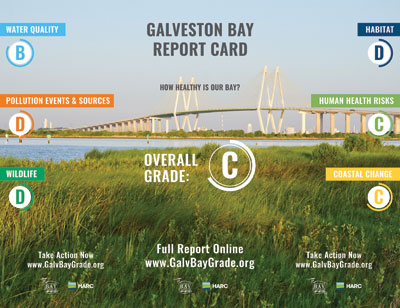Health Maintains “C” in Second Annual Report Card

For the second year in a row, Galveston Bay Foundation (GBF) and the Houston Advanced Research Center (HARC) released the Galveston Bay Report Card. Although the overall health of the Bay remained the same with a grade of “C”, interesting changes occurred within many of the categories analyzed.
The report card calls attention to 19 indicators impacting the Bay, the surrounding watershed, and ultimately, the health, livelihood and play of millions of Texans.
These indicators are grouped into six critical issues: water quality, pollution events and sources, wildlife, habitat, human health risks, and coastal change.
This year, our analysis once again led to an overall grade of “C” for Galveston Bay which is labeled as “adequate for now”. This is proof of the Bay’s resilience despite facing significant challenges such as pollution, declines in habitat acreage, and the impacts of coastal change.
Water Quality continues to be the highest scoring category and has improved from a B to an A this year, which is great news for the Bay and the Rivers and Bayous that flow into it. There is evidence that the progress begun with the Clean Water Act in 1972 and continued today in efforts associated with regional watershed protection planning are paying off.
Additionally, most fish and bird populations continue to hold steady in the Bay area and the brown pelican continues to be a shining example of a species that has come back from the brink of extinction.
On the other hand, the Rivers and Bayous flowing into Galveston Bay, including their surrounding watersheds, received a “D” in a new invasive species category because there are more than 90 species of invasive plants and animals established in the Galveston Bay watershed. The best way to control invasive species is to keep them out of our yards and waterways: if you don’t know it, don’t grow it!
Also, in the Toxins in Sediments indicator, legacy pollutants such as PCBs, dioxins, and DDT and pollutants such as mercury and pyrene associated with ongoing human activities can be found in the sediments around the Houston Ship Channel.
These pollutants can find their way into the Bay food web and even some of the seafood that we eat from these areas.
Visit the Report Card site, www.GalvBayGrade.org to see how your neighborhood measures up in terms of water quality, wetlands, and many other areas.
Research reveals what has changed this year.
